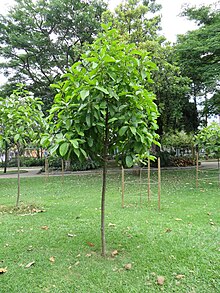Magnolia silvioi
| Magnolia silvioi | |
|---|---|

| |
| Scientific classification | |
| Kingdom: | Plantae |
| Clade: | Tracheophytes |
| Clade: | Angiosperms |
| Clade: | Magnoliids |
| Order: | Magnoliales |
| Family: | Magnoliaceae |
| Genus: | Magnolia |
| Section: | Magnolia sect. Talauma |
| Species: | M. silvioi
|
| Binomial name | |
| Magnolia silvioi (Lozano) Govaerts
| |
| Synonyms | |
|
Talauma silvioi Lozano | |
Magnolia silvioi is an endemic species of Antioquia department. Common names include: guanábano de monte, fruta de molinillo, guanabanillo.
Description
[edit]They are trees reaching up to 35 m height and 100 cm in diameter. Leaves alternate, simple, spirally arranged, coriaceous, elliptic, measuring from 11 to 26 cm long and from 7,4 to 12 cm wide; petiole greatly thickened at the base and present a scar that cover it completely. Flowers have cream color, two bracts up to 5 cm long covering the flower bud; three sepals and seven petals. The fruits are subglobose to ovoid, large, up to 16 cm long; 1-2 seeds per carpel with red cover.[1][2]
Distribution and habitat
[edit]






This is an endemic species of Antioquia department. It is distributed in Central Andes in two regions in Northeast and East of the department in the medium valley of Magdalena River. The altitudinal range goes from 400 to 1’550 m.[2]
Uses
[edit]In the past the wood was used in building structures for mining. Today is possibly used as saw timber.[3] It has great potential as ornamental and has been used with this purpose in Valle del Aburrá and has been shown good development.[2]
Conservation status
[edit]It is listed in category “Endangered” (EN) in the Red Book of Plants of Colombia[3] due to its small range distribution and also in forests subject to overexplotacion of saw timber and roundwood.[2]
References
[edit]- ^ Velásquez R., C. y Serna G., M. 2005. Magnoliáceas de Antioquia. Jardín Botánico Joaquín Antonio Uribe - CORANTIOQUIA - OIMT. Primera Edición. Medellín, Colombia. 32 p.; Lozano C., G. 1983. Magnoliaceae. Flora de Colombia, Monografía No 1. Instituto de Ciencias Naturales. Universidad Nacional de Colombia - COLCIENCIAS. Bogotá. 120 p.
- ^ a b c d Trujillo, L.; Agudelo, G.; Restrepo, M.; Cardona, E.; Murillo, J..Avances en la estrategia para la conservación de las especies de las familia Magnoliaceae en Jurisdición de CORANTIOQUIA, Medellín: CORANTIOQUIA, 2011 100.p. (Boletín Técnico Biodiversidad; No. 6, Diciembre 2011)
- ^ a b Calderón S., E.; A. Cogollo P; C. Velásquez R.; M. Serna G. y N. García.2007. Las magnoliáceas. Pp. 45-154. En: García, N. (ed.). Libro Rojo de Plantas de Colombia. Volumen 5: Las magnoliáceas, las miristicáceas y las podocarpáceas. Serie Libros Rojos de Especies Amenazadas de Colombia. Bogotá, Colombia. Instituto Alexander von Humboldt - CORANTIOQUIA - Jardín Botánico Joaquín Antonio Uribe- Instituto de Ciencias Naturales de la Universidad Nacional de Colombia - Ministerio de Ambiente, Vivienda y Desarrollo Territorial. 236 p.
External links
[edit]- Botanical Garden of Medellín, and its scientific Director Alvaro Cogollo, leading Magnolia conservation science in Antioquia department.
- South Pole Carbon, company leading a Magnolia conservation programme in Antioquia with the help of carbon finance.

